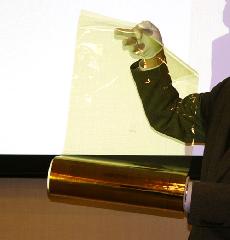Technology:
A research team led by Atsunori Matsuda of Toyohashi University of Technology developed a high-performance electrolyte film for fuel cell with a reduced additive amount of phosphoric acid. Using an inorganic compound with a high degree of conductivity of the hydrogen ion, the research team successfully reduced the additive amount of phosphoric acid to one third. The maximum output of a fuel cell using this electrolyte film reached the world’s highest level of 350 mW per square centimeter at 160 degrees centigrade without humidification.
The inorganic compound used for the electrolyte film is a powder made by mixing inorganic heteropoly acid containing tungsten and silicon with hydrogen cesium sulfate in a ball mill. The research team induced a chemical reaction by mixing them while giving impact mechanically. Because the surface is activated, the hydrogen ion has a high degree of conductivity, and the high degree of conductivity is maintained throughout a wide range of temperatures. Accordingly, the operation temperature of a fuel cell is between minus 20 to plus 160 degrees centigrade.
A research team led by Atsunori Matsuda of Toyohashi University of Technology developed a high-performance electrolyte film for fuel cell with a reduced additive amount of phosphoric acid. Using an inorganic compound with a high degree of conductivity of the hydrogen ion, the research team successfully reduced the additive amount of phosphoric acid to one third. The maximum output of a fuel cell using this electrolyte film reached the world’s highest level of 350 mW per square centimeter at 160 degrees centigrade without humidification.
The inorganic compound used for the electrolyte film is a powder made by mixing inorganic heteropoly acid containing tungsten and silicon with hydrogen cesium sulfate in a ball mill. The research team induced a chemical reaction by mixing them while giving impact mechanically. Because the surface is activated, the hydrogen ion has a high degree of conductivity, and the high degree of conductivity is maintained throughout a wide range of temperatures. Accordingly, the operation temperature of a fuel cell is between minus 20 to plus 160 degrees centigrade.

No comments:
Post a Comment